 AI
AI
 AI
AI
 AI
AI
We’ve been reporting that the COVID-19 pandemic has created a bifurcated information technology spending outlook — and now it’s clear that automation is emerging as one winner.
Legacy on-premises infrastructure and traditional software licensing models are giving way to approaches that enable more flexibility and business agility. Automation initiatives that reduce human labor with no added value has been gaining traction for the past 18 months.
In particular, the pandemic has accelerated the focus on such efforts, and the already hot market for robotic process automation, or RPA, along with machine intelligence have been beneficiaries relative to other segments of the IT stack.
In this Breaking Analysis, we’ll update you on the latest demand picture for the still-hot RPA sector. We want to focus on two main areas:
RPA gained traction by taking software robots and pointing them at existing applications to mimic human-keyboard interactions and automate repeatable and well-understood processes. A challenge with early RPA implementations is that most customers chose to point these bots at legacy back-office systems to open emails and fill in forms and the like — which digitizes processes around legacy systems. Great.
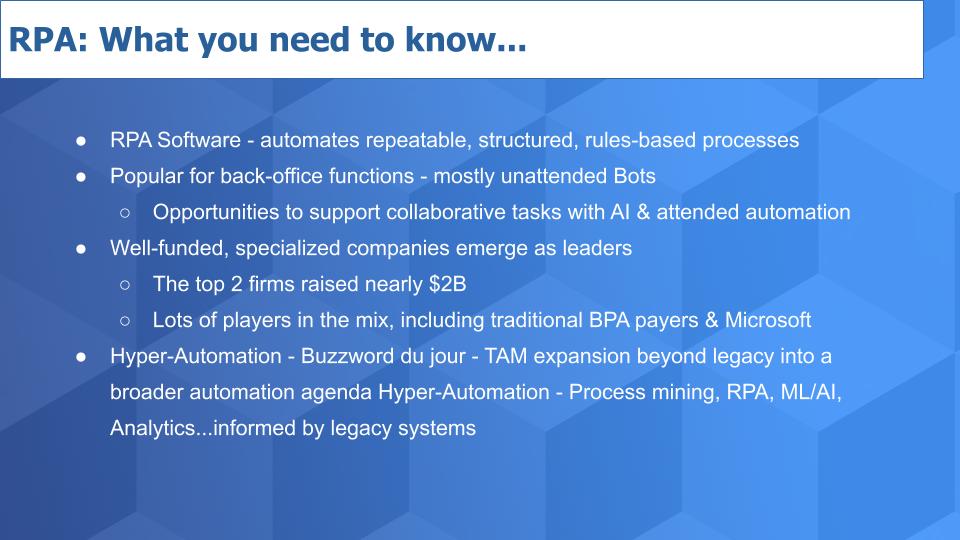
But the problem is that these bots interact with the user interface of the application and many of these apps have no application programming interface. So any change in data or the interface causes the automation to break down. More recently, automations are interacting with apps through APIs, which makes them less brittle, but of course the quality of the APIs will vary.
There has been lots of discussion around the intersection of RPA and artificial intelligence. That has allowed organizations to automate more processes and do so in a way that takes an augmentation approach – using natural language processing, speech recognition and machine learning to iterate and improve automations. This trend holds much promise, particularly in the form of trying to understand which processes to automate and where the best return on investment can be achieved. But it’s still early days.
Nonetheless, investors have piled into this market, as we’ve been reporting for some time now. UiPath Inc. and Automation Anywhere Inc. have raised close to $2 billion and have both been growing rapidly. Existing players such as Blue Prism Ltd. have benefited from the automation trend and legacy business process players like Pegasystems Inc. which started in the early 1980s, has added RPA to its platform. So have many others, including Microsoft Corp., which has been trying to crack into this market for a while.
In fact, Microsoft just bought a small company called Softomotive Ltd. this week to try to up its game. But in our view, Microsoft is far behind the leaders and it will take years for it to get to where the leaders are today. But it’s Microsoft, so we know not to ignore it.
The big buzzword du jour is hyperautomation. UiPath has picked up on it bigtime and so has Automation Anywhere, each with its own hyperautomation webpage. Those companies are in hypergrowth, so it plays well. More established companies – for example, Pegasystems – look at the term differently. Not surprisingly, RPA is only a small piece of its vision. More established firms want to incorporate their business process automations built over decades into a system view of the organization using existing platforms. The upstarts, of course, want to build from their platforms.
What’s happening, as in most polarized market situations, is a hybrid emergence. We saw this in mainframes coexisting with client/server, we saw it with traditional data warehouses fitting into big-data initiatives and we’re seeing it play out in cloud with multicloud and hybrid cloud. Most companies don’t throw away the investments they’ve made in legacy systems, since they’re stable and operationalized. Rather, they overlay the more modern technologies and create abstraction layers for their business that incorporate both old and new.
But the growth is much much higher in new, and that leads us to the total available market conversation.
We think the TAM expansion opportunity for RPA is substantial. We put together the chart below that underscores the progression of RPA from simple bots automating back-office functions to infusing automations and AI into all applications. If you expand the definition beyond RPA software into the broader automation opportunities, this market could be much larger than depicted here – perhaps well over a $100 billion opportunity as AI-powered automation becomes a fundamental part of every organization’s operating model.
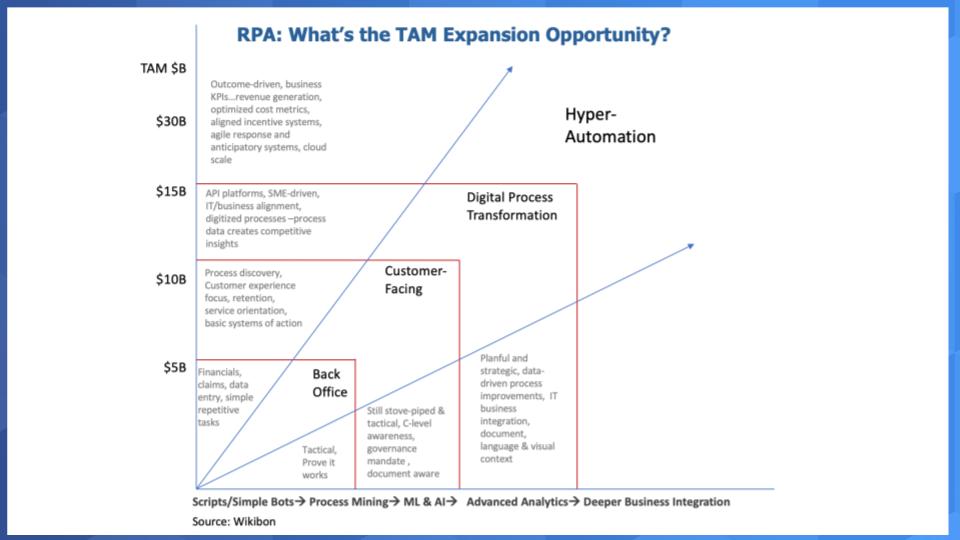
It’s a big opportunity and the data suggests that it’s growing rapidly. Let’s look at the spending action and bring Enterprise Technology Research survey data into the mix.
On balance, the tech sector has done quite well despite this pandemic. At the time of this post, the Nasdaq composite is up about 1.5% year-to-date. And we know from previous surveys that heading into 2020, there was a pullback and narrowing of new technology adoptions as organizations began to operationalize their digital initiatives.
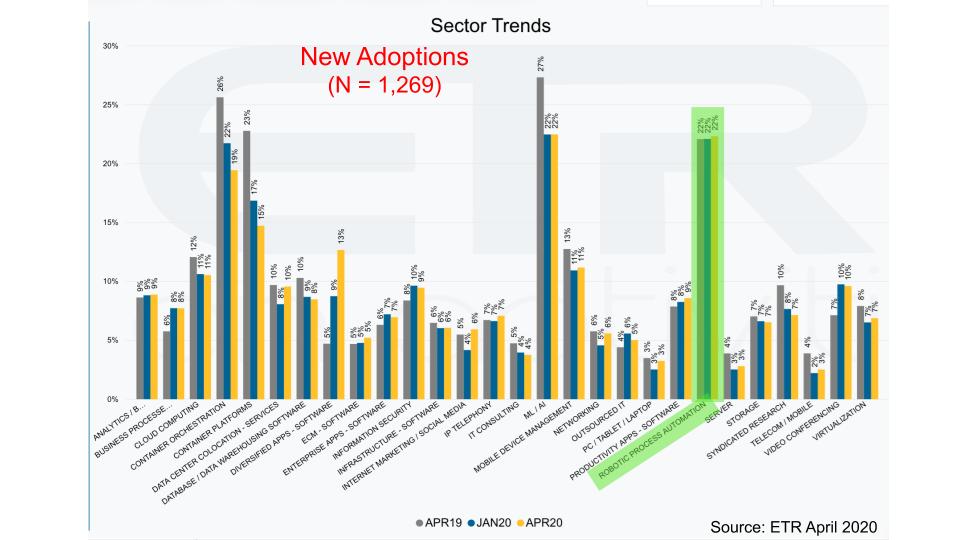
The chart above shows the new adoptions across three survey dates. The gray is April last year, the blue is January 2020 (pre-pandemic) and the yellow is the latest survey of more than 1,200 IT buyers. Remember this survey took place at the height of the COVID-19 lockdown. And you can see RPA with 22% new adoptions – meaning 22% of customers planning RPA spend are newly adopting RPA. That’s a figure as high as machine learning and AI. And of course as we’ve said, these technologies are increasingly playing together.
The data show RPA adoptions higher than containers, greater than videoconferencing (despite the work-from-home trend), more than cloud and more than mobile device management.
The chart below uses the two primary ETR metrics that we’ve been sharing over the past year. Net Score or spending momentum is on the y axis and Market Share – which is a measure of pervasiveness in the survey– is on the x axis.
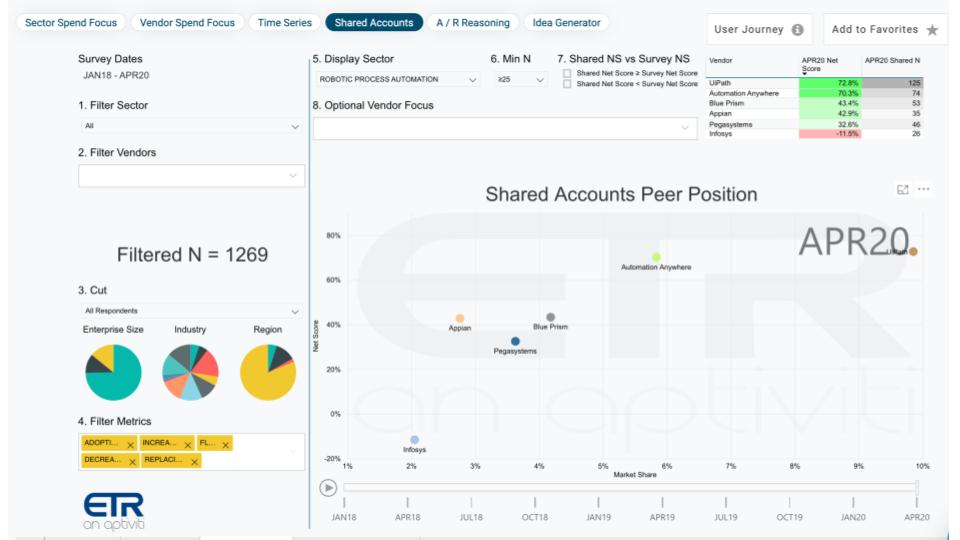
The chart plots the RPA players in the ETR data set and you can see UiPath in the far upper right in the brown dot and Automation Anywhere in the green. They are the two market leaders and both show strong spending momentum and market awareness.
Then you see Blue Prism and Pegasystems and the rest of the pack. We will say this about Pegasystems: After speaking recently with Chief Executive Alan Trefler, an amazing, self-made billionaire with a great business, we understand that Pegasystems is not an RPA play. RPA is only a part of its story. But it shows up in the ETR data set and certainly is automation-related, so we think it’s worth showing. However, it’s a bit of an oranges-and-tangerines dynamic.
In the upper right of this chart you can see the Net Scores in the mostly green shaded area. Remember Net Score is a simple metric like Net Promoter Score. It essentially subtracts customers spending less from those spending more and nets the difference. You can see the very strong Net Scores for both UiPath and Automation Anywhere, which we discuss below in detail.
The point is there’s lots of green on the chart and even Pegasystems, which is not considered an RPA specialist, has a solid Net Score.
This chart takes the three leaders, UiPath, Automation Anywhere and Blue Prism and plots their Net Scores over time – back to the January 2018 survey.
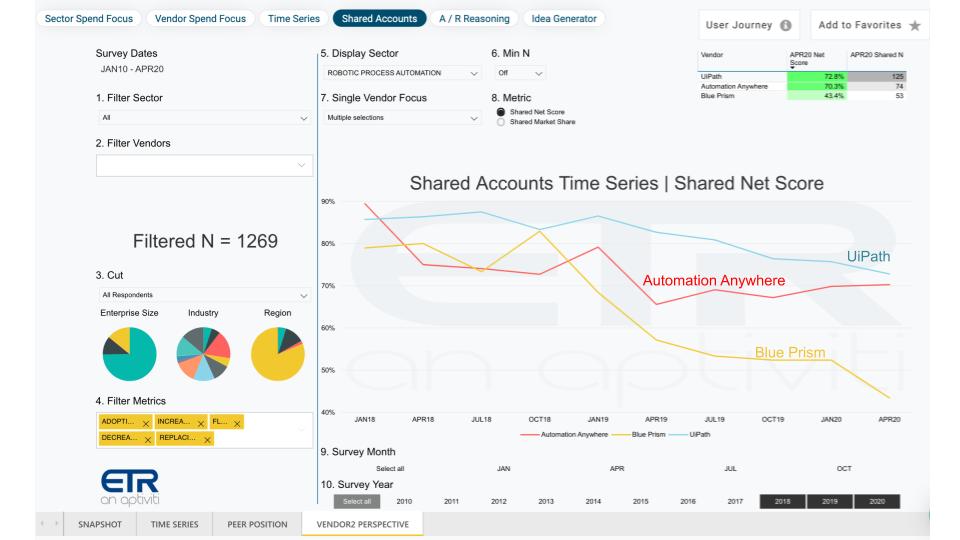
There are three points of relevance, including the following:
We know UiPath reported annual recurring revenue of $360 million last year and we also know the company continues to grow — we suspect somewhat faster than Automation Anywhere but that company does not share its ARR data publicly. In February we published estimates for the RPA vendors and pegged Automation Anywhere at $250 million.
If we expand the data slice from the Fortune 1000 to the Global 2000 where the N is larger, you see the picture changes somewhat from the overall data sample.

The chart above shows Net Scores in the Global 2000 where Ns are greater than 25 responses across all three companies. The gray bar is last April, blue is the January survey and yellow is April 2020. And you can see the year-on-year decline and the modest step down in the COVID-19 lockdown survey in April. But the Net Score levels are still elevated to 65% and 74%, respectively, for UiPath and Automation Anywhere, and 37% for Blue Prism.
The point is, COVID-19 has not crushed the RPA market. If anything, as witnessed by new adoptions, it’s better off than most sectors in IT.
Net Score is a very important metric and we want to spend a moment explaining how it can be most effectively utilized.The “wheel chart” below shows the Net Score method applied to UiPath from the April survey.

Net Score works by asking buyers – relative to last year – if they are adopting new (28%), increasing spend by 6 percent or more (51%), expecting flat spending (i.e. within +/- 5% – that’s 15% in the UiPath sample), planning to decrease spending by 6% or more (4% above); or replacing the vendor (2%).
You can see for UiPath, 79% of respondents (sum of the green) expect to increase spending in 2020 relative to 2019. Remember this survey was taken at the height of the COVID-19 lockdown.
Now let’s look at the data for Automation Anywhere.

Using the same methodology as described earlier, you can see that 72% of Automation Anywhere customers plan to spend more in 2020 relative to last year. Only 1% plan to spend less, with zero replacements. So we see very strong fundamentals as it relates to spending momentum for both UiPath and Automation Anywhere.
The last data point we will show relates to the metric of Market Share. Again, this is a measure of pervasiveness in the data set. It is calculated by dividing the number of mentions of a vendor in a sector by the total mentions of the sector – in this case RPA.
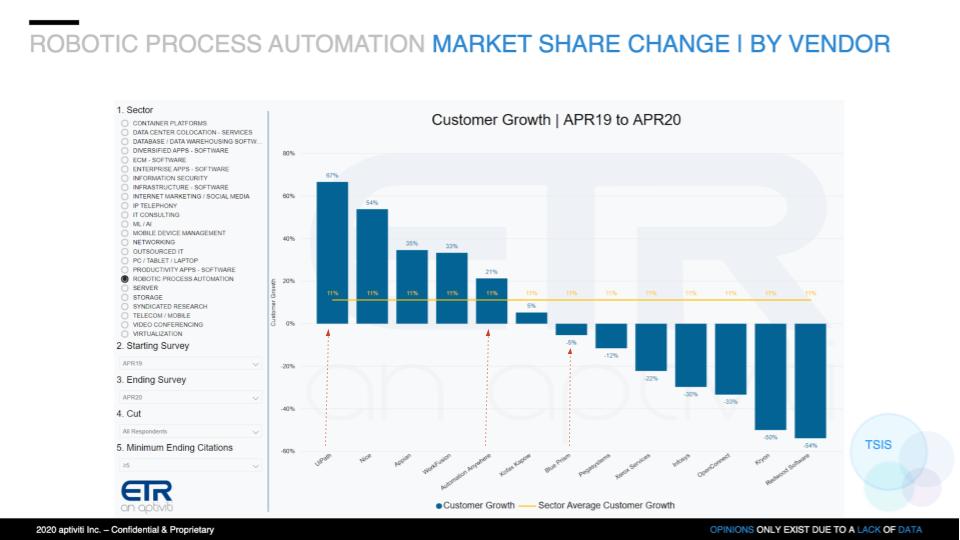
The chart above shows the year-on-year change in customer growth comparing Market Share from the April ’20 survey with the April ’19 data. The yellow line at 11% is the RPA sector average. UiPath has had the fastest share growth at 67%, Automation Anywhere is growing faster than the market at 21% and Blue Prism is below the average, at -5% share growth.
Now remember, this looks back to last year and it will be interesting to see how this picture changes with the next survey based on the earlier Net Scores we analyzed.
We’re seeing that the bifurcated market highlights automation as a trend that is real, and the RPA sector specifically shows us an example in action.
We think that had COVID-19 not hit, the RPA numbers would actually be higher, by as much as 10 percentage points. But in the near- to-mid-term we would expect a pretty fast return to a “normal” pattern of demand for RPA.
In fact, while we don’t expect a V-shaped recovery across the board, RPA is one area where we may see such a rebound. The pandemic underscores the need to accelerate digital transformations. RPA, we think, will be a central player in that movie along with AI and cloud.
Remember these episodes are all available as podcasts wherever you listen. – just search “Breaking Analysis Podcast” and please subscribe to the series. Check out ETR’s website. Also, check out this ETR Tutorial we created, which explains the spending methodology in more detail. We also publish a full report every week here and on SiliconANGLE.
Ways to get in touch: Email david.vellante@siliconangle.com, DM @dvellante on Twitter and comment on our LinkedIn posts.
Here’s this week’s full video analysis:
Support our mission to keep content open and free by engaging with theCUBE community. Join theCUBE’s Alumni Trust Network, where technology leaders connect, share intelligence and create opportunities.
Founded by tech visionaries John Furrier and Dave Vellante, SiliconANGLE Media has built a dynamic ecosystem of industry-leading digital media brands that reach 15+ million elite tech professionals. Our new proprietary theCUBE AI Video Cloud is breaking ground in audience interaction, leveraging theCUBEai.com neural network to help technology companies make data-driven decisions and stay at the forefront of industry conversations.